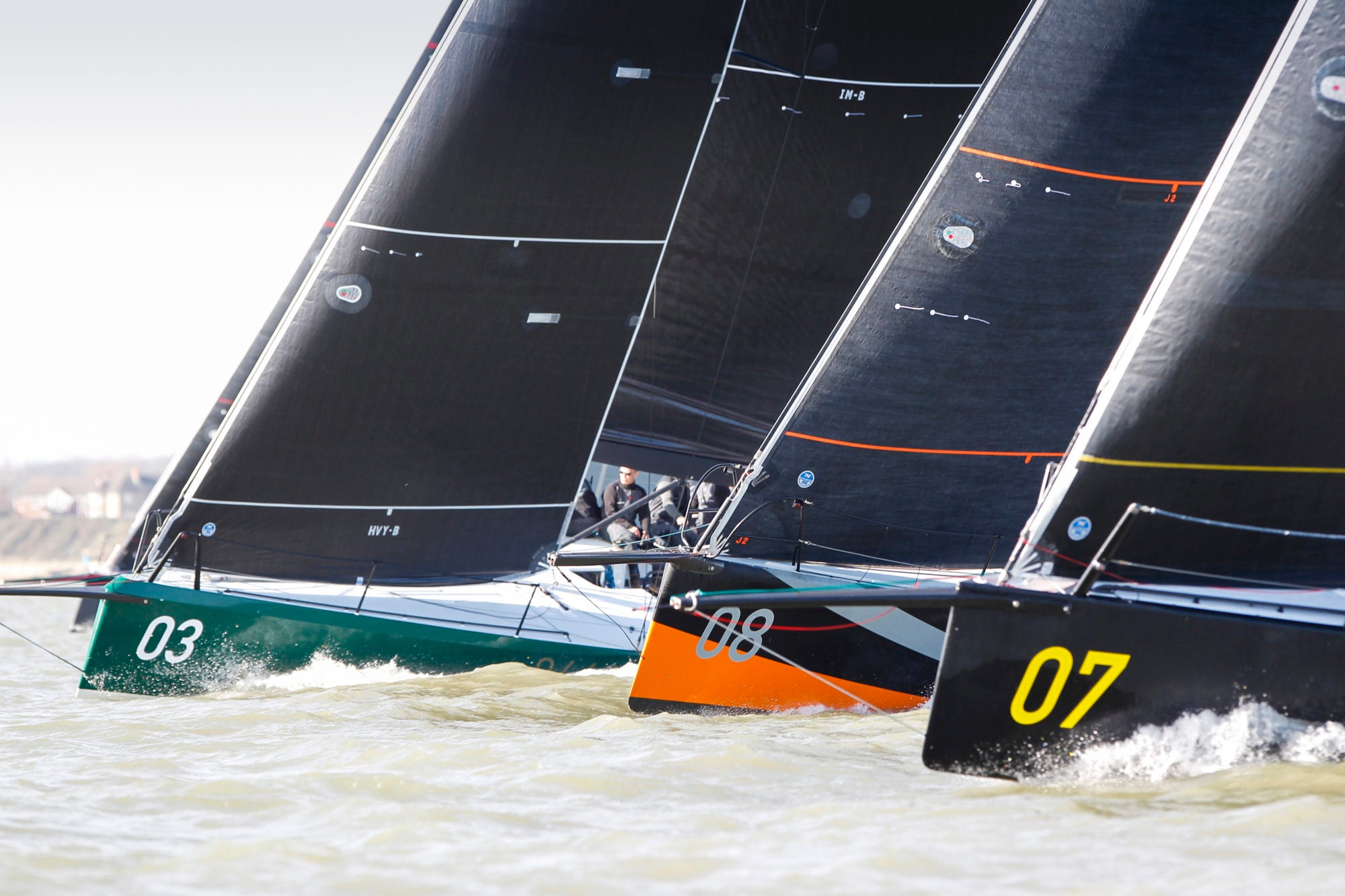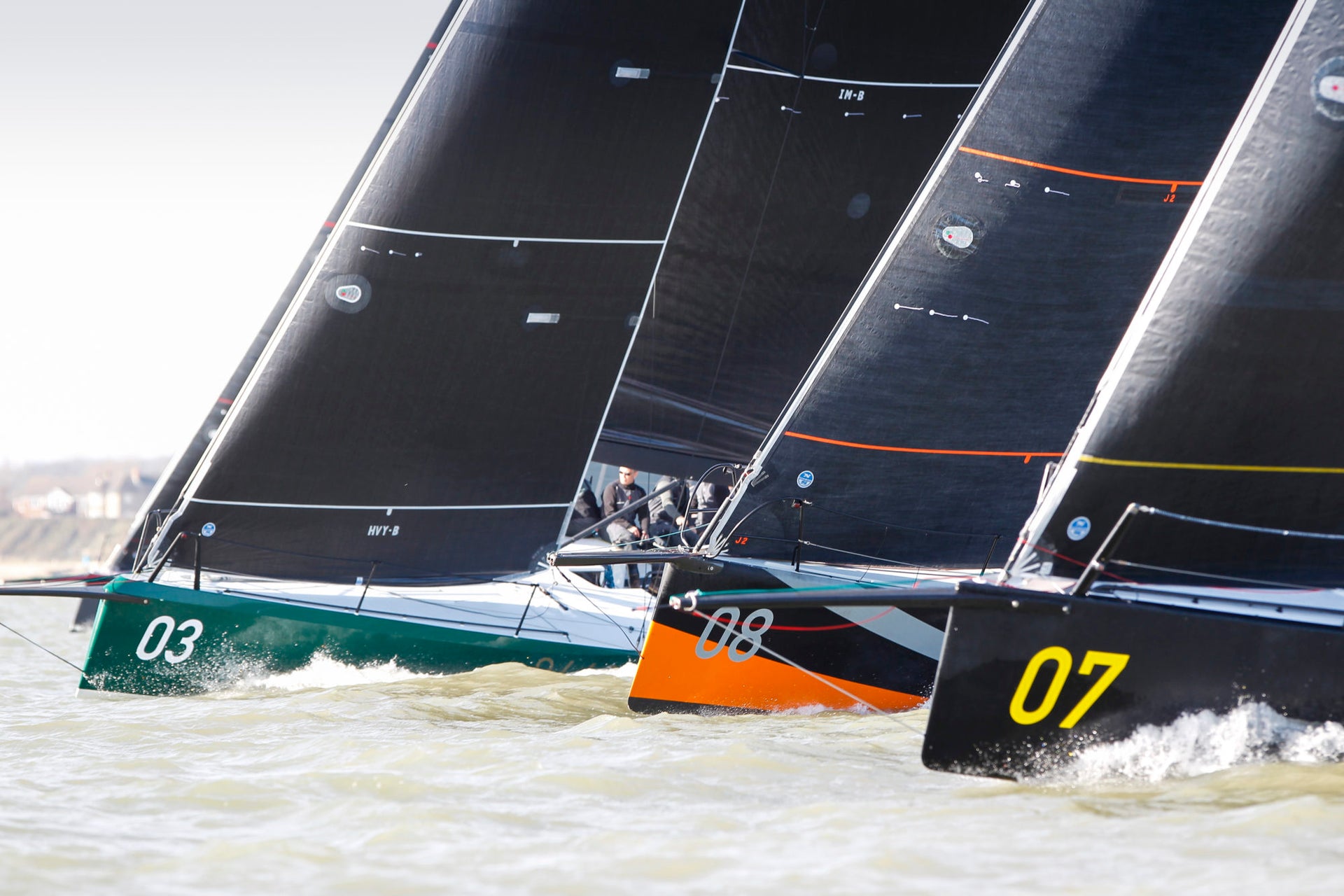UPWIND SAILS GUIDE
UPWIND SAILS GUIDE
Options Fit For Any Sailor

All sails can be described using four basic criteria – Size, Shape, Style and Specifications
- Size quantifies the two dimensional aspects of the sail: luff, leech and foot lengths, and the sail’s roach profile.
- Shape describes the three dimensional aerodynamic form built into these perimeter dimensions, which is commonly referred to as the Mold Shape.
- Style refers to the material used to build a sail.
- Specifications indicate the specific construction features such as hardware, reefs, luff attachments, fittings, and other sail handling systems.
North designers use complex numerical tools in concert with extensive empirical data to create unrivaled sails. The starting point is a well-suited mold shape selected from a design library with a fifty year lineage. The mold shape is then adapted to a particular target use, based on multiple inputs determined by our sail experts in consultation with our customers. Factors such as boat type, righting moment, rig geometry, sail size, material type, aspect ratio, wind speed, wind angle, sea state, mast bend and headstay sag are just some of the critical elements to successful sail design.
Navigating all of these variables can be challenging for even the best and most experienced sailors. Compounding the issue are the different languages of sailing used around the world. This guide is intended to help us speak a common language when describing sails.
Mainsail and Mizzen Mainsail Types
Standard Mainsail
This is our default mainsail type for both racing and cruising. Standard Mainsails may include up to 2 full-length battens and use conventional roach profiles that are customized to the boat’s geometry and customer requirement. Available in all material types, popular configurations are 1 full-length top batten for racing, and a “2 Plus 3” (2 full, 3 leech) batten configuration for cruising.
Full Batten Mainsail
Cruising Mainsail with more than 2 full-length battens. Available in all material types, usually paired with a luff car system and mechanical fasteners to batten receptacle.
High Roach Mainsail
Traditional cruising catamaran roach profile with full-length battens. Sometimes called a “Butter Knife” or algorithmic curve. The key feature of our High Roach Mainsail is that the batten can be designed parallel to the boom for easy flaking or boom furling. Available in all material types, but best suited for NPC Radian, NPL Tour, 3DL Marathon and 3Di Endurance styles to support the wide head angle.
Square Top Mainsail
Our most modern mainsail profile, with a head width supported by a gaff batten. Available in all material types, but best suited for NPL Sport, 3DL and 3Di.
Boom Furling Mainsail
Mainsails specifically designed for use on furling boom systems. Typically designed around a boom manufacturer’s specifications, these include special features like hard braid luff rope, leech plies and extra battens. Available in all material types, but best suited for NPC Coastal, NPC Radian, NPL Tour and 3Di Endurance.
Mast Furling Mainsail
Mainsails to be used with in-mast or external mast furling systems. Can be configured in a wide array of batten and roach profiles depending upon furling system and performance requirements. Available in all material types; best suited for NPC Coastal, NPC Radian, NPL Tour and 3Di Endurance.
Racing Headsail Types
Sails listed as headsails can be made either as Genoas or Jibs. Sails listed as Genoas are only made as overlapping headsails, while Jibs are only made as non-overlapping headsails.
Light Headsail
Maximum size specialty headsail for very low boat speed and boats that have other, full-sized headsails. Typically used when the boat is tacking through wide angles, with an emphasis on getting the boat moving. This mold has a full shape, with enough curvature in the leech to remain smooth when not sheeted in hard. Light Headsails will not perform well when trimmed in tight. The luff curve is designed for very straight headstay.
Super Light Headsail
Similar to Light Headsail but often made in the lightest cloth possible, with a very low maximum apparent wind speed rating.
Light/Medium Headsail
Maximum size headsail shaped for power more than pointing. Used when maximum upwind hull speed cannot be achieved or it is a struggle to maintain it.
Medium Headsail
Maximum size headsail used when the boat is powered up, but has still has not achieved maximum upwind hull speed. The Medium Headsail has a flatter shape that can be trimmed harder than a Light Headsail. The luff curve is designed for low headstay sag
Medium/Heavy Headsail
Maximum-sized headsail with an all-purpose mold shape. Geared slightly toward pointing more than power.
Heavy Headsail
Maximum, or near maximum size headsail used when the boat has reached maximum upwind hull speed. This shape is best when the boat will not go much faster, but can go higher by sheeting hard. This mold has a very straight leech and needs to be sheeted hard to remain smooth. The luff curve is designed for moderate headstay sag.
#2 Genoa
Reduced size genoa designed to fill the gap between the Heavy Genoa and #3 Jib. This mold has a very flat shape and a very straight leech to allow for a wide sheeting angle. The LP, mid-girth and luff length are designed around the rig geometry. This sail may not sheet well around some spreader arrangements and is not suitable for all boats. The luff curve is designed to match moderate headstay sag.
#3 Jib
A non-overlapping headsail for heavy air use on boats that also carry genoas. This sail sheets inboard of the shrouds and in front of the mast, which allows the mainsail to be eased or traveled down without backwinding. This sail is typically sized with a maximum foot length and mid-girth to fit in front of the rig. It has a round entry and very straight back to power through waves while maintaining pointing.
# 4 Jib
Reduced size Jib for use when the mainsail is reefed or nearly reefed. This sail is short of maximum luff length and has a reduced foot length to allow effective steering in large waves and reduce mainsail backwind.
Heavy Weather Jib
Similar to #4 Jib but sized to Offshore Special Regulations (OSR) guideline.
Furling Genoa
All Purpose Roller Furling headsail with an LP greater than 110%. Designed for a wide range of wind speeds and angles. The material must be low stretch to hold shape in heavy air, and strong enough to handle furling and rig impact. Designed with a shape similar to Light/Medium Racing Genoa, it is optimized for eased out, upwind trim in the middle of the target wind range.
Furling Jib
All Purpose Roller Furling headsail with LP less than 110%.Typically designed for modern cruising boats that utilize non-overlapping headsails. Can also be designed as a heavy weather specific sail for cruising boats that also carry overlapping genoas.
Self-Tacking Jib
All Purpose Roller Furling headsail with LP less than 110%. Designed for modern cruising boats that utilize non-overlapping headsails with a lateral, self-tacking sheeting track. Commonly fitted with a clewboard for sheeting adjustment, and optional vertical battens.
Yankee
All Purpose, high clewed headsail for cruising. May be set on roller furler or fixed stay. The high clew enhances reaching performance and improves visibility. Commonly used on cutter rigs or boats with an inner Jib.
Inner Jib / Inner Fore Staysail / Staysail
Small Jib set on an inner forestay. May be set on roller furler or fixed stay. Typically designed as a heavy weather jib, but also used a Genoa Staysail for cutter and double head rigs.
Storm Sails
Storm Trysail
Designed to attach to mast and sheet independently from the boom. Typically set on a dedicated luff track, its size is based on Offshore Special Regulations (OSR) guidelines.
Storm Jib
Designed to attach to headstay or inner stay with luff tape or hanks. Size is based on Offshore Special Regulations (OSR) guidelines.



























